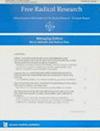EP4 receptor agonist CAY10598 upregulates ROS-dependent Hsp90 cleavage in colorectal cancer cells.
IF 2.9
3区 生物学
Q2 BIOCHEMISTRY & MOLECULAR BIOLOGY
引用次数: 0
Abstract
Prostaglandin E2 (PGE2) interacts with four specific G protein-coupled receptors, namely EP1, EP2, EP3, and EP4, playing a pivotal role in determining the fate of cells. Our previous findings highlighted that stimulating the EP4 receptor with its agonist, CAY10598, triggers apoptosis in colon cancer HCT116 cells via the production of reactive oxygen species (ROS). This process also reduces the phosphorylation of the oncogenic protein JAK2 and leads to its degradation in these cells. In this study, our goal was to explore the pathways through which CAY10598 leads to JAK2 degradation. We focused on Hsp90, a heat shock protein family member known for its role as a molecular chaperone maintaining the stability of several key proteins including EGFR, MET, Akt, and JAK2. Our results show that CAY10598 decreases the levels of client proteins of Hsp90 in HCT116 cells, an effect reversible by pretreatment with the ROS scavenger N-acetyl cysteine (NAC) or the proteasome inhibitor MG132, indicating that the degradation is likely driven by ROS. Furthermore, we observed that CAY10598 cleaves both α and β isoforms of Hsp90, the process inhibited by NAC. Inhibition of EP4 with the antagonist GW627368x not only prevented the degradation of Hsp90 client proteins but also the cleavage of Hsp90 itself in CAY10598-treated HCT116 cells. Additionally, CAY10598 suppressed the growth of HCT116 cells implanted in mice. Our findings reveal that CAY10598 induces apoptosis in cancer cells by a novel mechanism involving the ROS-dependent cleavage of Hsp90, thereby inhibiting the function of crucial Hsp90 client proteins.EP4受体激动剂CAY10598能上调结直肠癌细胞中依赖于ROS的Hsp90裂解。
前列腺素 E2(PGE2)与四种特定的 G 蛋白偶联受体(即 EP1、EP2、EP3 和 EP4)相互作用,在决定细胞命运方面起着关键作用。我们之前的研究结果表明,用激动剂 CAY10598 刺激 EP4 受体,可通过产生活性氧(ROS)引发结肠癌 HCT116 细胞凋亡。这一过程还能减少致癌蛋白 JAK2 的磷酸化,并导致其在这些细胞中降解。在本研究中,我们的目标是探索 CAY10598 导致 JAK2 降解的途径。我们重点研究了 Hsp90,它是一种热休克蛋白家族成员,因其作为分子伴侣维持包括表皮生长因子受体、MET、Akt 和 JAK2 在内的多种关键蛋白的稳定性而闻名。我们的研究结果表明,CAY10598会降低HCT116细胞中Hsp90客户蛋白的水平,这种效应在ROS清除剂N-乙酰半胱氨酸(NAC)或蛋白酶体抑制剂MG132的预处理下是可逆的,这表明降解可能是由ROS驱动的。此外,我们观察到 CAY10598 可裂解 Hsp90 的 α 和 β 异构体,而 NAC 可抑制这一过程。用拮抗剂 GW627368x 抑制 EP4 不仅能阻止 Hsp90 客户蛋白的降解,还能阻止 CAY10598 处理的 HCT116 细胞中 Hsp90 本身的裂解。此外,CAY10598 还能抑制植入小鼠体内的 HCT116 细胞的生长。我们的研究结果表明,CAY10598通过一种新的机制诱导癌细胞凋亡,该机制涉及依赖于ROS的Hsp90裂解,从而抑制关键Hsp90客户蛋白的功能。
本文章由计算机程序翻译,如有差异,请以英文原文为准。
求助全文
约1分钟内获得全文
求助全文
来源期刊

Free Radical Research
生物-生化与分子生物学
CiteScore
6.70
自引率
0.00%
发文量
47
审稿时长
3 months
期刊介绍:
Free Radical Research publishes high-quality research papers, hypotheses and reviews in free radicals and other reactive species in biological, clinical, environmental and other systems; redox signalling; antioxidants, including diet-derived antioxidants and other relevant aspects of human nutrition; and oxidative damage, mechanisms and measurement.
 求助内容:
求助内容: 应助结果提醒方式:
应助结果提醒方式:


